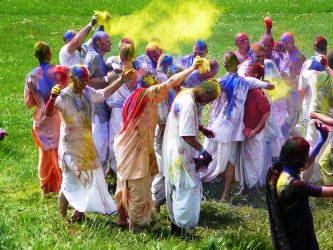Holi![]() (Video of celebrative dancing at Holi)
(Video of celebrative dancing at Holi)
Known as the Festival of Colors, Holi is a Hindu festival celebrated throughout India and other areas with a major Hindu influence, such as North America, Europe, Africa and other parts of southern Asia. According to Hindu tradition, the demon king, Hiranyakashipu, was granted “eternal life” from Brahma. The boon (blessing) stipulated that Hiranyakashipu could not be killed during the day or night, inside or outside his home, on earth or in the sky, or by man nor animal. Because of this protection, Hiranyakashipu grew arrogant and denounced the Gods and ordered everyone to pray to him. Prahlada, Hiranyakashipu’s son, was a devout follower of Lord Vishnu and became upset at the outrageous claims his father was making. Hiranyakashipu ordered Prahlad not to worship Vishnu but Radhu persisted. Hiranyakashipu then tried unsuccessfully to have his son killed, as Prahlada survived poisoning, trampling, biting and fire. In one incident Prahlad and his sister were induced to sit on a pyre. Holika, who was believed to be immune to fire, was consumed while Prahlad was unscathed. It is in Holika’ memory that the festival is celebrated under the name Holi. It was then that Lord Vishnu took action. He came in the form of a half man-half lion, and killed Hiranyakashipu at dusk on the porch, killing him on his lap, thus avoiding the boons that protected Hiranyakashipu.
 Holi is celebrated at the end of the winter season and the beginning of spring, usually February or March, during the last full moon day of the Hindu month of Phalguna. Like most festivals, it lasts for several days, and in some areas is celebrated for several weeks. Holi is celebrated in a variety of ways in different countries, but there are a number of common rituals. A bonfire is also typical of Holi; participants will gather around the fire, which symbolizes the death of the demons and demonesses. One of the most distinctive rituals involves participants throwing colored powder and water on one another, which is why the holiday is referred to as the Festival of Colors.. In more traditional cultures, it was the ashes of the bonfire that were used during the color throwing ceremony. Holi is also a time of feasting, and those participating in the festivities begin to prepare lavish meals well in advance of the celebration. The holiday is noted for a suspension of social distinctions based on gender, caste, social status, and age as well as social norms governing conventional propriety, which creates a carnivalesque atmosphere.
Holi is celebrated at the end of the winter season and the beginning of spring, usually February or March, during the last full moon day of the Hindu month of Phalguna. Like most festivals, it lasts for several days, and in some areas is celebrated for several weeks. Holi is celebrated in a variety of ways in different countries, but there are a number of common rituals. A bonfire is also typical of Holi; participants will gather around the fire, which symbolizes the death of the demons and demonesses. One of the most distinctive rituals involves participants throwing colored powder and water on one another, which is why the holiday is referred to as the Festival of Colors.. In more traditional cultures, it was the ashes of the bonfire that were used during the color throwing ceremony. Holi is also a time of feasting, and those participating in the festivities begin to prepare lavish meals well in advance of the celebration. The holiday is noted for a suspension of social distinctions based on gender, caste, social status, and age as well as social norms governing conventional propriety, which creates a carnivalesque atmosphere.
Profile prepared by Josh Jolly
May, 2009
